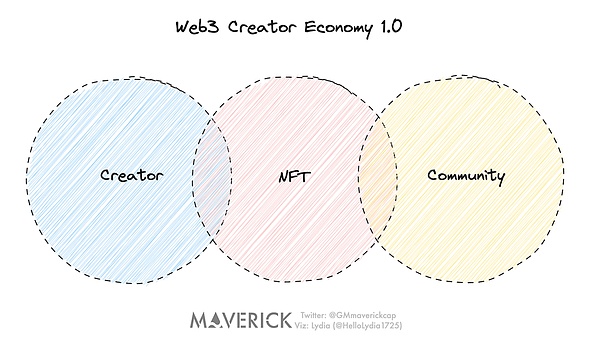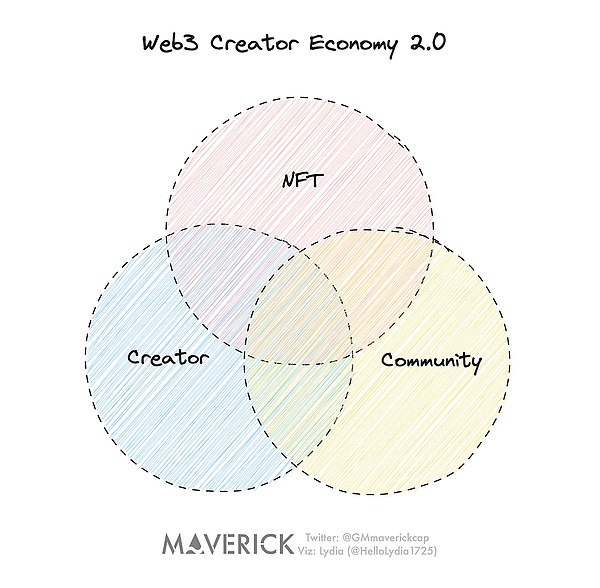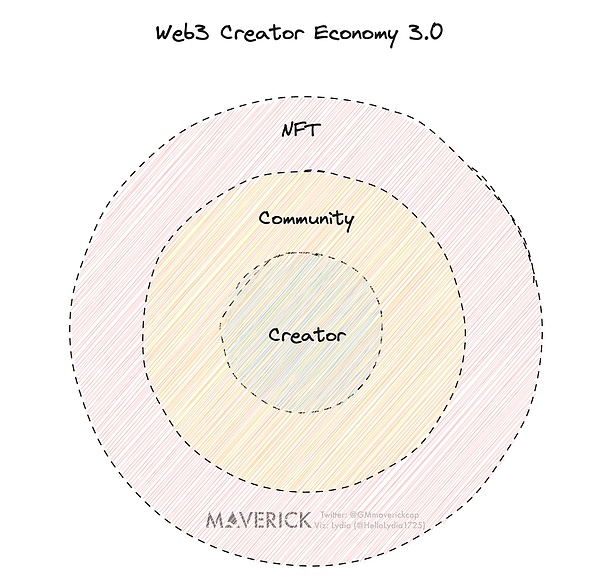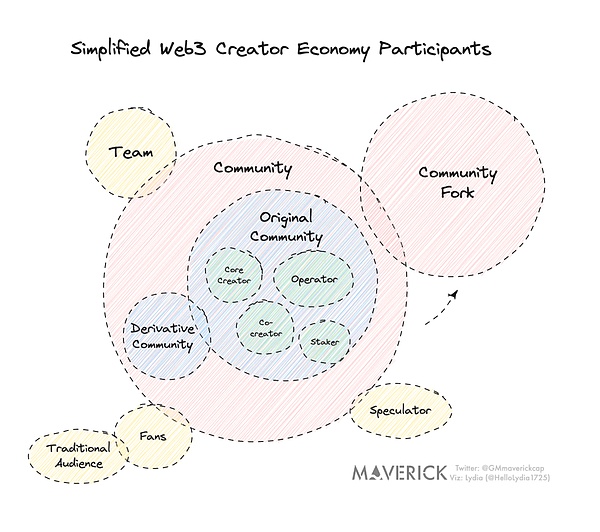Compiled by: Lydia Wu, SevenUp DAO
Understanding begins with not accepting the surface world as the world. All possibilities of understanding are rooted in the ability to say no.
– Susan Sontag, “On Photography”
Mastering the Medium: NFT and the Creator’s iPhone Moment
The myth of the Web3 creator economy began with the attention value brought by blockchain, which gives uniqueness to every difference and every transaction (a thousand ships of Theseus?). As the main container of on-chain native content, is the emergence of NFT the creator’s “iPhone moment”? We will first briefly review the relationship between NFTs and creators.
Web3 Creator Economy 1.0 The initial stage of the Web3 creator economy followed the simplest “blockchain+” logic, adopting a centralized content creation + Web3 distribution model, mainly to solve the revenue problem of traditional (especially long-tail) creators.
The main role of NFT in this stage is packaging. Personal artists or project parties have cast their own creations into NFTs, placed them on platforms for distribution, and a large number of Web3 creator platforms such as Mirror have emerged as a result. Platforms only charge a small fee, creators get most of the revenue, and cost items are almost negligible, attracting the initial followers of this novel profit model.
Indeed, a small group of pioneers tasted the sweetness of Create-to-Earn, and many NFT project parties became later blue chips, but NFTs as distribution channels have limited value-added effects on works. With more and more projects, most of those who make money by issuing NFTs are still celebrities who already have influence. For ordinary creators, the wealth effect of Web3 is not significant (not to mention the barriers), and most ordinary creators and platforms have not been able to survive the winter.

Web3 Creator Economy 2.0
The success or failure of the previous stage of projects depends heavily on head creators and star holders, and community participation is mainly concentrated in the distribution link. In order to retain more supporters in the stock competition, NFT creators began to pay more attention to the role of the community. In this stage, the (semi-)decentralized content creation + Web3 distribution model is adopted to explore bringing the community into content creation one step earlier in order to increase participation and loyalty.
At this stage, NFTs have added the function of coordinating community co-creation in addition to being distributed as end products. This stage has seen the emergence of a group of co-creation media platforms and community creation DAOs. Shibuya, Storyverse, Mad Realities, and others have cast Blockingss cards as NFTs, serving as equity certificates covering voting rights, derivative NFT airdrop rights, and subsequent revenue sharing rights in the creative process.
Such a mechanism needs to be built on naive imagination of creative behavior, which is also the focus of the second section of this article. In short, the pain point of this stage is that the co-creation value and necessity of some content forms are not yet clear, after all, historically, 80% of people will only be lurking.

Web3 Creator Economy 3.0
It is not difficult to see that NFTs have inherent community genes. In the process of Web3 creator economy development, the community has tried to take over content production from buying and speculating, to participating in governance, and finally to content co-creation.
Although the decentralization of creative power means that the upper limit of individual creation becomes lower and the decision-making process is also prone to become complex, we believe that community content co-creation is still a direction worth exploring. What can be certain is that Web3 does not expect to have better genius creators (such as the top 1%) than Web2, but it cares about what the remaining 99% of people can do together.
What kind of content form can not only sustain the enthusiasm of the community’s participation, but also maintain the simplicity and beauty of governance? We boldly speculate that the Web3 creator economy 3.0 stage will be an unprecedented collision of native on-chain content and governance mechanism innovation. But before that, there are still some important questions waiting to be answered.

Sandra: What do you mean by “taming the truth”?
Fei Lun: It is to enter a forbidden zone of expression. Overthrow the stories that are told because of laziness, peacekeeping, convenience, and fear, and break the things that make us self-justified, easy to believe, and acceptable to everyone.
——”Paris Review”
The Moment of Disenchantment: Three Questions about Creator Economy Logic
The Web3 creator economy needs a “wake-up call.” The establishment of the current 2.0 phase narrative depends on a long chain of user behavior as a prerequisite:
Ownership – Loyalty – Community Co-creation – Creative Explosion.
This section will break down these three linkages in order to awaken our senses that have been shielded by familiar vocabulary.
1. Can ownership bring loyalty?
1) Ownership does not necessarily bring loyalty
The magic bullet theory of ownership has long had counterexamples in the real world. Buying shares of a company means becoming a shareholder and having legal ownership, or “actual ownership,” but most shareholders are not naive enough to believe that a part of the company belongs to them. Similarly, Web3 investment activities should not be casually linked to emotions or loyalty – consider whether you can become the user’s favorite project first.
At the same time, it is unfair to accuse Web2 of not respecting user ownership. Most successful Web2 products create a “my feeling” for users’ accounts through elegant and personalized user experiences, and through active community operations, they make users feel close and belong to the platform. This psychological ownership can even penetrate into the subconscious area and achieve a “false reality” effect – users will feel that this account “belongs” to them until it is banned (rather than taken back).
2) Loyalty does not necessarily depend on ownership
The rational person hypothesis is mostly ineffective in the content industry. The value of content depends on people’s attention, and the best example may be idol and talent shows like AKB48. Fans determine the idol’s position and future resources through voting. The core of the idol economy is “power by love.” Fans pursue a “connection” with idols through dedication and devotion, not “possession”, and this loyalty is more pure because it does not require ownership and there is no return rate.
The success of open source communities like Linux also proves that creators are not always profit-driven animals. Hackers are committed to the development of open source community projects not because they pursue any economic value, but because Linux has created an efficient ego-boosting market, that is, the increase of individual reputation in the group.
For creators, the ideal scenario for creator economy is the “ownership double-killing effect” driven by emotion. However, the mainstream users of Web3 are often speculative and profit-driven, which makes it more uncertain for creators to obtain user loyalty and psychological ownership.
2. Do fans have to be creators?
Everyone has a microphone, but it does not mean that everyone has to report news or engage in non-fiction writing. The right, willingness, and ability to create should be progressive.
The by-product of the ownership myth is that the complex role division in the Web2 content ecology (creators, fanfiction writers, old fans, new fans, die-hard fans, passive fans, bystanders, critics, station sisters, scalpers, etc.) are all packaged into a basket called owners, demanding the same participation standard, and constrained by a simple process. Creative behavior involves choice, ability, and opportunity, but should not be a threshold or obligation.
Moreover, for most projects, identifying excellent ideas is as crucial as excellent ideas themselves. If the performance on stage lacks the applause from the audience, it will not be complete, and it is easy to fall into the trap of self-indulgence.
3. Will the result of decentralized collaboration be a creative revolution or mediocre democracy?
What does human collaboration mean in the process of creating meaning?
In the spring of 2016, including Liu Cixin, 12 writers completed a science fiction work together in the form of “storytelling relay.” However, this co-creation activity of “China’s top science fiction writers” was not smooth-sailing–it is said that everyone groaned on the phone when they received the previous novel from another writer. And the final work was far from “storytelling relay” and more like 12 thematic writings from different authors.
It is currently difficult to imagine larger-scale, fully decentralized creative activities, even to start. Will this be a socialist revolution in the creative field?
The form of DAO basically gives up the possibility of reform driven by innovative individuals, and the introduction of tokens makes economic incentives a variable that affects content production–this does not mean that it is impossible, but its output will be difficult to measure by traditional evaluation standards. A creative outburst? Mediocre democracy? A performance art? All are possible.
The true, unique, and only progress of civilization that occasionally lingers in one’s mind is to create conscious death.
— Camus, “The Wedding Collection”
A Thousand Miles in One Step: A New Variable in the Creator Ecology
Web3 creators already have the ambition to challenge Web2 content products, but the process is not smooth. This section will, based on the previous thinking, propose directions worth trying in the transition from the Web3 creator economy 2.0 stage to the 3.0 stage dominated by on-chain native content.
1. Crowd segmentation is a prerequisite for collaboration
A simple one-person, one-vote system is no longer applicable to content creation in the 3.0 stage. The essence of co-creation is not that everyone completes 1% of the progress bar, but that everyone has something to contribute. When designing a project, the crowd should be segmented to help users find their respective positions. Just like building a house together, some people design, some dig foundations, some build frames, some fill walls, some decorate, and some cut ribbons.
The following is a simplified diagram:

It is worth noting that people should not be fixed in their initial roles, the system should be open, and the friction of role transitions between different participants should be reduced. Flexible role division and a looser organizational structure are important features that distinguish the content industry from other industries. Here, the enthusiastic and open market mode often inspires more creativity than the rigorous and complex cathedral mode.
2. Optimize user experience and complex deflation design
The market mode cannot start from scratch. MVP (Minimum Viable Product) should be established when the community is established to attract the first batch of interested users.
However, the UX of Web3 products has long been criticized, and perhaps only speculators driven purely by profit can withstand it. Only by optimizing the user experience, maintaining user attention, can we promote a virtuous cycle of “psychological ownership-actual ownership”. At the same time, the token deflation model and incentive design are complicated (intangible), avoiding the influx of speculators and maintaining the atmosphere of the existing community.
3. Progressive decentralization and CC0
The purpose of co-creation is to create better works or more happiness, not to prove anything to Web2. It is not unreasonable for a centralized team to propose original ideas worth trying in the beginning. We need a progressive decentralization process to find a balance between sustainability, creative standards, and community culture. The corresponding output results should also circulate first in Web3 (to a certain extent of trade protection), without accepting the verification of Web2 standards in advance.
In the process of gradually introducing more community participation, the CC0 transformation may be the key to self-growth, which means opening up existing IP as a composable creative infrastructure. The control of the transformation timing involves the coordination of the interests of the holders, which is also very important. Only by ensuring the scarcity of the source and superimposing the frictionless derivative creation of CC0 can the possibility of Web3 co-creation be maximized.
4. Creators should pay taxes on their influence
Don’t get me wrong, I’m not against royalties. I’m just saying that the founding team shouldn’t make so much profit at the beginning. Think about how Bloot made collectors get nothing while the project side still made a lot of royalties.
The reason why the content platform of Web2 can get such a high share from creators (in the form of traffic or advertising) is because it bears the responsibility and risk of content distribution. The content distribution task of Web3 is largely borne by the community. The concept behind ERC-721C is to make on-chain programmable and transferable royalties possible, and the idea is to distinguish core supporters from holders and give them the appropriate economic gifts.
When attracting creators to enter Web3, don’t expect them to take everything away. The income recovered from the Web2 platform should be shared with the community, which is also the taxation of the influence they obtained from the community.
Keeping the desire for something is an essential part of happiness.
—Russell “The Conquest of Happiness”
Conclusion: The Next Decade of On-Chain Native Content
Since the birth of new media, innovation has just begun.
Ten years after the release of the Bitcoin White Paper, the ERC-721 standard came into being. On-chain native content will record the next decade of the blockchain industry through NFT as a carrier.
Our definition of native on-chain content is: a new type of cultural product that is semi-artificial and semi-programmatic, generated through on-chain interactions, closely related to the traceability, permanence, free circulation, and composability of the blockchain itself. Based on this concept, we are not very optimistic about on-chain use cases such as TikTok, but we are very interested in full-chain games and dynamic NFTs generated by on-chain activities, such as entropes and OG.Art. If you have creative ideas or observe interesting cases, please join us in witnessing.
Ultimately, the most important point of the Web3 creator economy is not in the economic sense, nor in the technical sense, but in the sociological sense. The history of large-scale human cooperation will open a new chapter, and the media history will add a page of new content from a world of transparent rules, free circulation, and eternal existence.
Like what you're reading? Subscribe to our top stories.
We will continue to update Gambling Chain; if you have any questions or suggestions, please contact us!